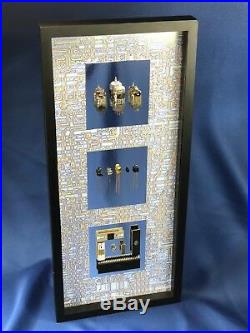Three Generations of Computing Technology vacuum tube, transistor, computer chip




General purpose computers started in the 1950s using vacuum tubes for electronic switches. These replaced the special purpose relay-based calculators that. To transistors with a major increase in reliability and speed, lowered cost. The 1970s and beyond have been dominated by integrated circuit silicon chips. The density of transistors on these chips went from single digits to the billions in the 21st century, roughly doubling every 2 years.
Here are artifacts used in this artwork. Section A: 1st Generation - Vacuum Tubes.
1, 2, 3 IBM Computer Vacuum Tubes. Section B: 2nd Generation - Transistors. Western Electric (Bell Labs) 2N559.Section C: 3rd Generation - Integrated Circuits. AMI 2063 Serial Communication Chip. Mostek 5002 4-Digit Counter/Display Decoder. Motorola 356 ECL 3-Input OR/NOR.
Intel 8752 Microcontroller with EPROM. The artwork is framed in an 9"x20" black shadow box frame, with glass.
All framing materials are acid free. A narrative about the artwork that includes the artists signature is placed on the back of the artwork. Limited by availability of chips. Want to see more ChipScapes? Computer chips start out as ordinary sand, which is silicon dioxide.However, the silicon must be made very, very pure. The first step is to melt the sand, in a furnace that reaches about 3200. F, and mix with carbon. This first purification process creates 99% pure Silicon, a common output is Silicon Carbide.
The Silicon Carbide is processed in a trichlorosilane distillation method to create 99.9999% pure silicon called polycrystalline silicon. The polysilicon is broken up into chunks. These chunks are melted in a crucible at about 2500.
A silicon crystal seed is dipped in molten silicon and slowly drawn out to create a cylinder of silicon. These silicon cylinders are some of the purest crystals on the planet. Once the silicon cylinder is grown to the desired diameter, it is sawed into wafers.
These wafers are polished to achieve a very flat mirror surface. Transistors, and other micro-electronic parts, are built on the polished wafer in layers in a process called etching. The wafer is then sawed into its individual chips. Each chip is mounted in an electronic package that serves to protect it and connect it to the outside world.
It has been said that computer chips are the greatest value added product in the world. We essentially take a pile of sand and change it into thousands of dollars worth of computer chips. These artworks are the creation of. Are photographs taken of computer chips, boards, and other computer artifacts. They are sort of chip landscapes, or. Most often a macro-lens or microscope is used with special lightning to achieve these unique artworks. Intel, IBM, Fairchild, DEC, Signetics, Intersil, AMD, Zilog, Motorola, MOS, NEC, Texas Instruments, are some of the great chip making companies. Chips like the Intel 4004, MOS 6502, Zilog Z80, AMD 2901, IBM PowerPC and others have changed the way people work and play. Are dedicated to preserving and sharing these computing and communication technologies that changed the world. Artworks are fine collectible artworks. Come is a variety of shapes sizes and colors.Clusters of my artwork make for stunning displays! Would make a great gift for the nerd, geek, engineer, programmer, IT executive, or just that technology savvy person in your life. For more information about ChipScapes.
Please check out my ChipScapes. For more information about chip collecting as a hobby.The item "Three Generations of Computing Technology vacuum tube, transistor, computer chip" is in sale since Saturday, February 2, 2019. This item is in the category "Art\Mixed Media Art & Collage Art".
The seller is "chipscapes" and is located in Winter Park, Florida. This item can be shipped worldwide.
- Subject: Computer Chips
- Type: Collage
- Size: Medium (Up to 30in.
)
- Style: Impressionist
- Materials: Paper, Silicon, Metal
- Original/Reproduction: Limited Edition
